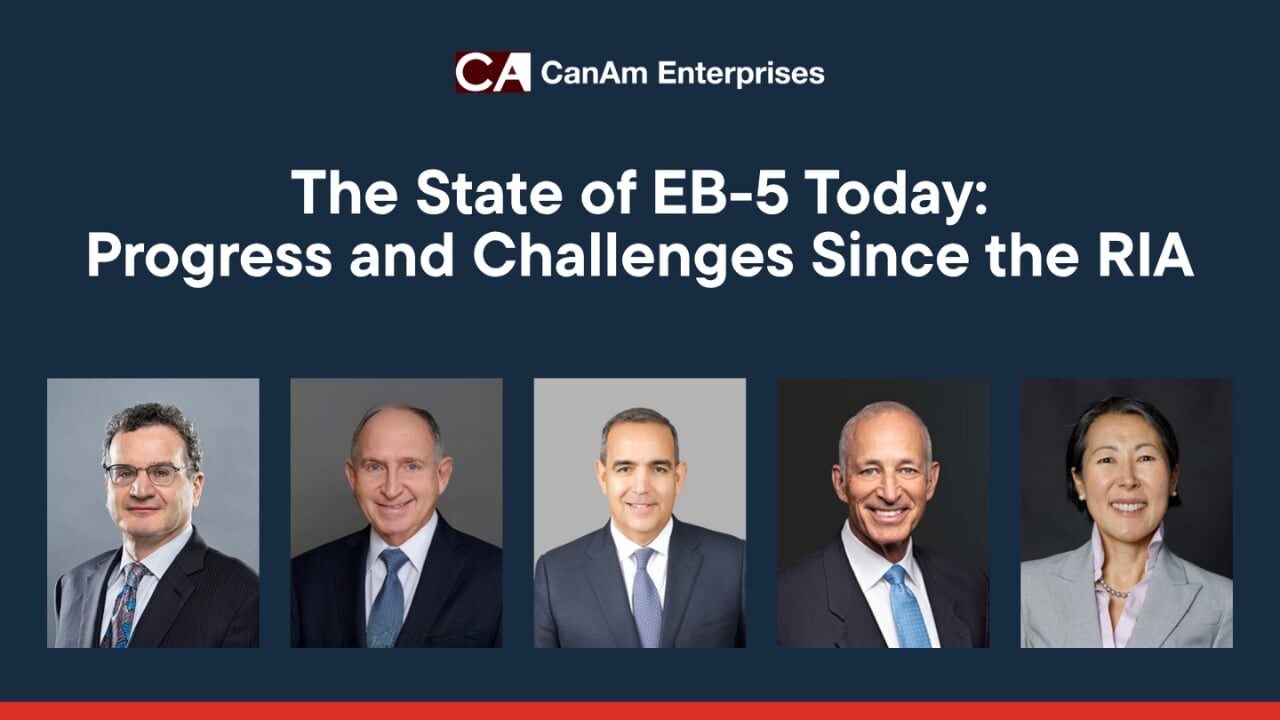Part 2 of CanAm’s Series on EB-5 Adjudication Trends with Jen Hermansky and Pete Calabrese
When Investors Ask: “Can I File Now and Fund Later?”
With the EB-5 Reform and Integrity Act (RIA) protecting investors who file before September 30, 2026, it’s no surprise that many prospective applicants are eager to secure a priority date.
But what happens if your funds aren’t all ready yet? Can you partially fund your investment, file your I-526E, and still qualify as being “in the process of investing”?
That’s the question that Greenberg Traurig Shareholder Jen Hermansky and CanAm Investor Services CEO Pete Calabrese explored in Part 2 of their recent discussion on current USCIS adjudication trends.
“It’s entirely possible to fund in installments,” Hermansky explained, “but it has to be done correctly—and you have to prove you’re truly committed to investing the full amount.”
The Context: Why Partial Funding Has Become So Popular
The RIA’s grandfathering clause has created a sense of urgency. Investors who file before the 2026 deadline are protected even if Congress later allows the EB-5 Program to lapse. Understandably, that’s motivating some to file as soon as possible—sometimes before all $800,000 has been transferred.
As Calabrese noted, “Getting that priority date locked in is important, but predictability and compliance have to come first. Filing prematurely can create bigger problems down the road.”
What the Law Actually Says: ‘In the Process of Investing’
The ability to file before contributing the full investment isn’t new. It’s built into EB-5 law itself.
“The statute has always said that an investor can be in the process of investing,” Hermansky explained. “That language dates back to 1990, and it wasn’t changed by the Reform and Integrity Act in 2022.”
However, another long-standing rule still applies: the petition must be approvable when filed. That means you can’t fix a weak or incomplete case later by changing key elements of your investment.
The challenge, Hermansky said, is reconciling those two concepts—proving you’re in the process of investing and showing that your petition is approvable at the time of filing.
What USCIS Expects to See
To meet that standard, Hermansky emphasized that partial funding is permissible only when three conditions are satisfied:
- An initial capital contribution must already be made.
“It would never be acceptable to file with no money remitted,” she said. “Even remitting only an administrative fee, with no part of the $800,000 investment, would lead to an easy denial.”
- A binding agreement must commit you to the remaining installments.
The investor and the new commercial enterprise (NCE) should have a side-letter agreement or similar documentation stating exactly when and how the remaining funds will be transferred. USCIS looks for a present commitment—not just an intention to pay later. - The lawful source of funds for the future installments must already be documented.
USCIS now wants to see not only your plan for funding but the proof of where those funds will come from. “It’s no longer enough to say, ‘I’ll sell property or receive a bonus,’” Hermansky noted. “You must provide documentation showing those funds are real and traceable.”
A New Level of Documentation
In earlier years, USCIS sometimes approved cases where the investor’s later installments weren’t fully traced at filing. Today, that leniency has disappeared.
“If you’re going to fund $400,000 now and $400,000 three months later,” Hermansky explained, “USCIS expects to see exactly how that second installment will be financed—before you even file.”
She also cautioned that missing installment deadlines could create problems. “We’re still waiting to see how strictly USCIS enforces that, but planning ahead is key,” she said.
Calabrese agreed, adding:
“It’s not enough to know you can cover it—you have to show it. USCIS wants to see that every step of the process is documented and consistent.”
Proactive Updates: Don’t Wait for an RFE
One emerging best practice, according to Hermansky, is to send in documentation of subsequent installments proactively—even before USCIS issues a Request for Evidence (RFE).
“Once you’ve made that second installment,” she advised, “don’t wait. Mail in the proof of funding, the path of funds, and any supplemental documentation.”
While USCIS hasn’t yet published a formal inter-filing procedure for EB-5 cases, submitting additional evidence early helps ensure that the agency has the full picture before adjudicating.
“If USCIS wants investors to follow a particular process,” Hermansky added, “they should tell us what that process is. Until then, being proactive protects the investor.”
Practical Takeaways for Investors
For investors preparing to file partially funded EB-5 petitions, Hermansky and Calabrese outlined several key steps:
- Remit a meaningful first installment — typically at least half of the $800,000.
- Execute a written agreement with the NCE outlining exact payment timelines.
- Document all sources of both the initial and remaining funds, including evidence of lawful origin.
- Stay on schedule—missing an installment deadline may raise red flags.
- Update USCIS proactively once the remaining funds have been transferred.
Each of these steps reduces the risk of a denial and increases the likelihood that USCIS will view the case as fully approvable when filed.
Balancing Urgency with Readiness
With the September 2026 grandfathering deadline approaching, the urgency to file is real—but so are the risks of filing too early.
“The priority date doesn’t matter if the petition gets denied,” Calabrese reminded investors. “Taking an extra month to prepare everything correctly is always worth it.”
Hermansky agreed: “EB-5 is a life-changing investment. Waiting to make sure your documentation is airtight is far easier than dealing with a denial later.”
What’s Next in the Series
This discussion on installment funding is just one piece of the bigger picture. In the next installment, CanAm and Greenberg Traurig examine how loans are being treated under the RIA—and why proper structuring matters more than ever.
- Part 3: Loans and EB-5 — What’s Allowed, What’s Risky, and What’s New Under the RIA





